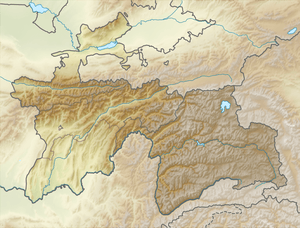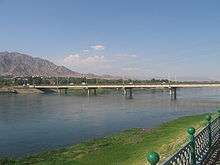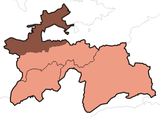Sarazm
|
Sarazm | |
 Location of the site in Tajikistan | |
| Location | Sughd Region, Tajikistan |
|---|---|
| Region | Zarafshan Valley |
| Coordinates | 39°31′N 67°34′E / 39.517°N 67.567°ECoordinates: 39°31′N 67°34′E / 39.517°N 67.567°E |
| Type | Settlement |
| Official name | Proto-urban Site of Sarazm |
| Type | Cultural |
| Criteria | ii, iii |
| Designated | 2010 (34th session) |
| Reference no. | 1141rev |
| Region | Asia-Pacific |
Sarazm is an ancient town and also a jamoat in north-western Tajikistan. It dates back to the 4th millennium BCE and is today a UNESCO World Heritage site. It is located in Panjakent District in Sughd province.[1]
The archaeological site of the ancient city of Sarazm is located near Durman, a town situated in the Zarafshan Valley of north-west Tajikistan in the Sughd province near the border with Uzbekistan.
Site description
The site indicates an early steppe presence in the Zarafshan Valley. Around 3000 BC, it was the largest exporting metallurgical center of Central Asia.[2] It was abandoned after the arrival of the Andronovo settlers, around 2000 BC.
The city is believed to have been revived as a mining point to collect from nearby sources of turquoise.[3] Established no later that 1500 BC, the city also served as an important regional agricultural and copper production center.[4]
Wheat (free-threshing hexaploid) and barley (both naked and hulled) were discovered at the site, while evidence for broomcorn millet and pulses were not found. The naked barley found at Sarazm is similar in morphology to the barley found in sites in Pakistan such as Mehrgarh and Nausharo, and also similar to the barley found in the earliest sites in China where barley was first found.[5]
The town was discovered in 1976 by a local farmer named Ashurali Tailonov who found a copper dagger protruding from a nearby construction site.[6] It was excavated by Abdullo Isakov and French archaeologists beginning in 1977.
World Heritage Site status
The proto-urban site of Sarazm was inscribed on the World Heritage List in July 2010 as "an archaeological site bearing testimony to the development of human settlements in Central Asia, from the 4th millennium BCE to the end of the 3rd millennium BCE".[7] It is the first World Heritage Site in Tajikistan.
References
- ↑ "List of Jamoats". UN Coordination, Tajikistan. Retrieved April 4, 2009.
- ↑ Kuzʹmina, E. E. (2007). The origin of the Indo-Iranians. Leiden, the Netherlands Boston: Brill. p. 212. ISBN 9789004160545.
- ↑ Anthony, D.W. (2008) p 419
- ↑ Anthony, D.W. (2008) p 419
- ↑ Spengler, Robert N.; et al. (2013). "Archaeobotanical results from Sarazm, Tajikistan, an Early Bronze Age Settlement on the edge: Agriculture and exchange". Journal of Environmental Archaeology. 18 (3). doi:10.1179/1749631413Y.0000000008.
- ↑ Central Asian river | PRI's The World
- ↑ http://whc.unesco.org/en/list/1141/
Bibliography
- Neolithic Settlement Sarazm - UNESCO World Heritage Centre Retrieved 2009-03-04.
- Anthony, D.W. (2008), The Horse, the Wheel, and Language: How Bronze-Age Riders from the Eurasian Steppes Shaped the Modern World, Princeton University Press. ISBN 0-691-05887-3
- Central Asian river | PRI's The World Retrieved 2009-03-04.


